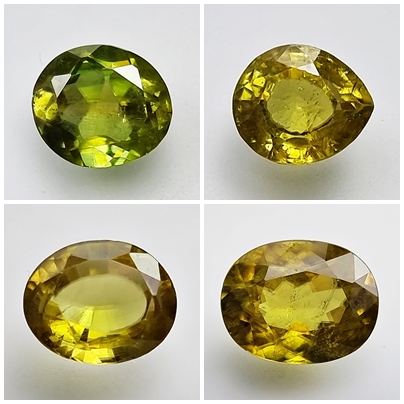Sphene: Gemstones Information
Introduction to Sphene:
Sphene, also known as titanite, is a rare and brilliant gemstone renowned for its exceptional dispersion and fiery brilliance. Named after the Greek word “sphenos,” meaning wedge, sphene often forms in wedge-shaped crystals with distinct pleochroism, meaning it displays different colors when viewed from different angles. With its dazzling play of colors and high refractive index, sphene has captured the fascination of gem collectors and connoisseurs worldwide.
Physical Properties:
Sphene is a calcium titanium silicate mineral with the chemical formula CaTiSiO5. It belongs to the nesosilicate mineral group and typically forms in metamorphic and igneous rocks, such as gneiss, schist, and granitic pegmatites. Sphene crystals often exhibit a range of colors, including yellow, green, brown, and red, with occasional flashes of orange and pink. Its brilliance and dispersion, which refers to its ability to separate white light into spectral colors, make sphene a highly prized gemstone.
Appearance:
The most distinctive feature of sphene is its remarkable dispersion, which gives it a fiery brilliance reminiscent of diamond. When faceted, sphene exhibits vivid flashes of color, often displaying a play of greens, yellows, and reds that dance across its surface. Sphene’s pleochroism adds to its visual appeal, as it can appear different colors when viewed from different angles. Its luster can range from subadamantine to resinous, depending on the quality of the specimen.
Metaphysical Properties and Benefits:
Sphene is believed to possess various metaphysical properties and benefits, drawing on its energetic properties and symbolic associations. Some of the potential metaphysical properties and benefits associated with sphene include:
Creativity and Inspiration: Sphene is said to stimulate creativity and inspire artistic expression. It is believed to awaken the imagination, ignite passion, and encourage innovative thinking, making it an ideal gemstone for artists, writers, and musicians seeking inspiration.
Positive Energy and Vitality: Sphene is associated with promoting positive energy and vitality. It is believed to uplift the spirits, dispel negativity, and infuse the wearer with a sense of joy and enthusiasm for life. By aligning with the solar plexus chakra, sphene is thought to enhance confidence, courage, and self-esteem.
Harmony and Balance: Sphene is said to promote harmony and balance within the body, mind, and spirit. It is believed to soothe emotional turmoil, reduce stress and anxiety, and foster a sense of inner peace and tranquility. By aligning with the heart chakra, sphene can help facilitate emotional healing and reconciliation.
Manifestation and Abundance: Some believe that sphene has the power to attract prosperity, abundance, and success into one’s life. It is thought to amplify the Law of Attraction, helping individuals manifest their desires and achieve their goals with greater ease and efficiency.
Spiritual Growth: Sphene is often used in meditation and spiritual practices to deepen one’s connection to the divine. It is believed to facilitate spiritual growth, enhance intuition, and promote enlightenment and spiritual awakening.
There are several ways to harness the energies of sphene:
Wearing Jewelry: Wearing sphene jewelry, such as rings, pendants, or earrings, allows you to carry its energy with you throughout the day and benefit from its metaphysical properties.
Meditation: Holding a piece of sphene during meditation can enhance your spiritual practice and promote deep relaxation, focus, and inner exploration.
Placement in the Home: Placing sphene specimens or carvings in your home or workspace can infuse the environment with its vibrant energy and promote a sense of creativity, vitality, and abundance.
Visualization: Visualizing yourself surrounded by a sphere of sphene energy can help you tap into its metaphysical properties and align with its healing and transformative energies.
Incorporating into Rituals: Sphene can be incorporated into rituals or ceremonies aimed at manifestation, emotional healing, or spiritual growth, enhancing their effectiveness and potency.
Sphene is a rare and exceptional gemstone prized for its fiery brilliance and metaphysical properties. Whether worn as jewelry, used in meditation, or placed in the home, sphene offers a powerful tool for enhancing creativity, vitality, emotional balance, and spiritual growth. By incorporating sphene into your life, you can tap into its vibrant energy and experience its transformative effects firsthand.





